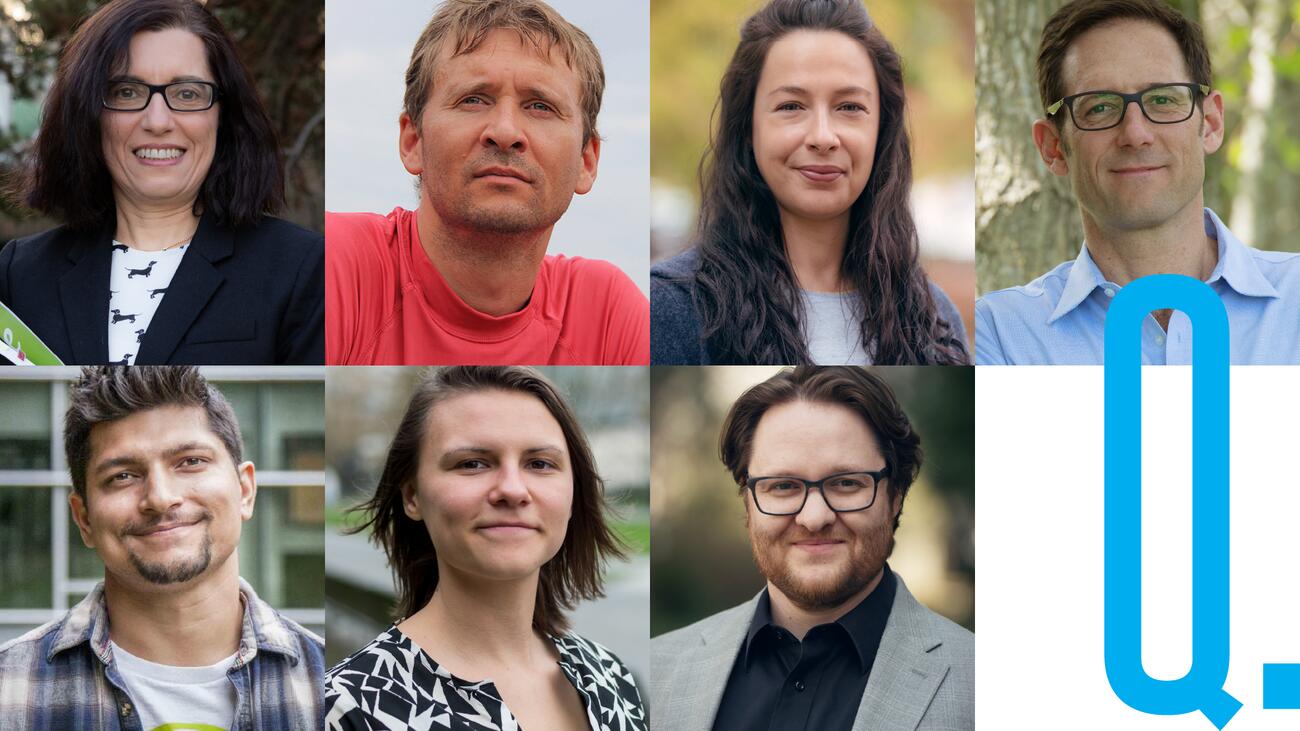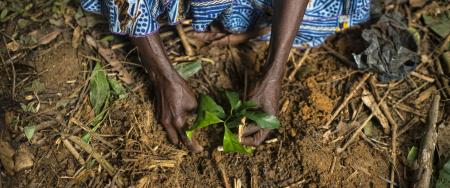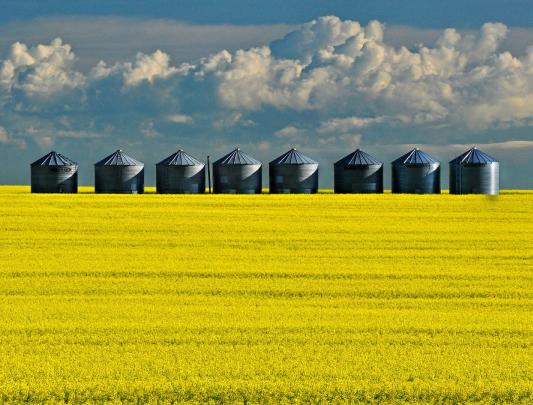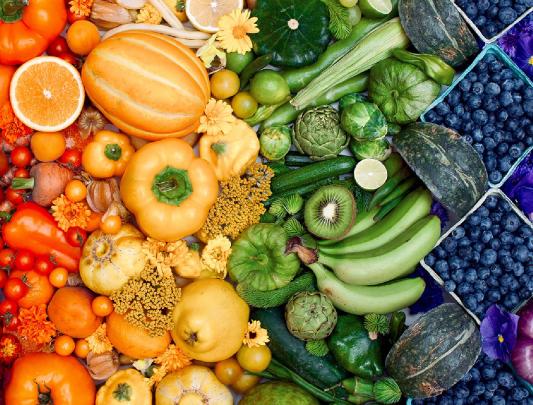
Top (L-R): Victoria Shroff, Nathan Pelletier, Tabitha Robin Martens, Sean Smukler
Bottom: Evan Bowness, Rachel Mazac, Derek Dee
Collective Wisdom
Can (and should) we remove animals from our food system?
One pressing question, multiple expert perspectives.
Animals play an important role
Sean Smukler
Principal Investigator, Sustainable Agricultural Landscapes Lab
Chair, Agriculture and Environment, Faculty of Land and Food Systems
Some suggest fixing our broken food system requires removing animals from it completely. While it may be possible, someday, to replace the consumption of animals with plant-based foods and synthesized meat, this is not likely to be universally effective or a desirable solution.
In many parts of the world, animals play an important role in providing nutrient-dense food on lands that otherwise would not be food-producing. Livestock that is effectively integrated with crop production diversifies and enhances producer resilience while helping cycle nutrients and building soil health. Animals are also an important part of food culture around the world. Any changes in our consumption must consider social, ecological, and economic outcomes, locally and globally.
Looking for easy technological fixes is partly how we got into this predicament in the first place. Clearly, we need to change the way we raise animals, so their welfare and impacts on the environment are addressed. Certainly, we need to figure out how to have fewer animals on the planet. Eating less meat would help achieve that and so would a lot fewer people.
Diversify our food system
Derek Dee
Assistant Professor, Food Science
As the world population grows and we face sustainability challenges (land and water use, energy consumption, and GHG), we will need to adjust our food system. Given the challenges of meat, particularly beef, we need to adopt other foods that are at least as appealing, affordable, and healthy. It is not an all-or-none situation – animals will continue as part of our food system for the foreseeable future – but the proportion of animals-as-food will need to decrease.
With improved nutritional knowledge, we don’t need to eat animal products for optimal health. Food scientists have been working on numerous alternatives to animal-based foods, including plant-based meat/dairy analogues, recombinant proteins and fats, cell-tissue cultured meat, and insects and algae. Food choices are driven mainly by taste, cost, and convenience (and healthfulness), and we have more work to do to meet or excel in these categories. But we now have supercomputers and biotechnology – and the motivations – so it can be done.
Animals are sentient
Victoria Shroff, BA’90, LLB’96
Adjunct Professor, Animal Law
Author of Canadian Animal Law, (Lexis Nexis 2021)
The future of food is animal free. Not only can we remove animals from the food system, we must, for the sake of animal equity and climate change.
Farming animals for food is not justifiable from the point of view of the sentient animal who is raised for slaughter, cooked, and speared on the end of a fork for consumption. Animals used in Canada's industrial food complex are sentient cogs in a multi-billion dollar commercial, for-profit industry. While Darwin may have helped the world overcome the notion that animals were not mere automatons, in modern industrial agriculture, they arguably still are. Studies demonstrate that pigs are as smart as toddlers, that cows have complex emotional lives.
The climate crisis is another pressing reason why the food system must pivot away from using animals. Our planet needs protection via plant and alternatively sourced food initiatives, such as lab-grown meat, where mass slaughter of animals is eliminated and greenhouse gas emissions are heavily reduced.
Consider the context
Nathan Pelletier
Associate Professor, Faculty of Science (Biology) / Faculty of Management (UBC Okanagan)
Egg Farmers of Canada Research Chair in Sustainability
Animals have always been crucial in food systems – whether as stores of exchange value, an assurance of food security or, most importantly, recyclers of biomass not otherwise suitable for human consumption.
Indeed, livestock today comprise the single greatest recycling system in history. Even vegan diets are underpinned by activities that create large streams of biomass for which sufficient human demand simply does not exist (for example, okara, which is a co-product of tofu production). For these reasons, the well-established Food Waste Reduction Hierarchy suggests that the best use of such biomass (i.e., prior to considering waste-to-energy conversion or composting) is to feed it to livestock in order to produce human-palatable products.
Livestock are clearly over-produced and over-consumed in some contexts, resulting in a variety of challenges. In others, food security and health outcomes would be improved by increased availability. The more interesting question is in what contexts, by which means, and at what levels should we produce livestock so as to best meet a variety of important resource efficiency, ecological, socio-economic, and animal welfare objectives.
The transition must be just
Evan Bowness, PHD'21
Affiliate, Centre for Climate Justice at UBC; Research Associate (University of Manitoba)
Acting Director, Food and Agriculture Institute (University of the Fraser Valley)
Policy makers, farmers, researchers, community organizers, and industry leaders should lead a transition away from industrial animal agriculture.
Industrial animal agriculture refers to raising livestock in an intensive way at large scale for the lowest possible cost. But it is harmful to ecosystems (through concentrations of emissions and other forms of pollution), to workers (through exploitative and dehumanizing labour practices), to consumers (through diet-related health issues and risk of zoonotic diseases) and to animals (through the terrible conditions in which these animals live and die).
Food systems should minimize these risks and harms. However, many farmers and farmworkers depend on industrial animal agriculture for their livelihoods. And any change that makes food more expensive is not an option for consumers and communities who are already facing the threat of food insecurity.
So, the challenge lies in designing and implementing a transition away from industrial animal agriculture that protects those who face disruption, especially marginalized social groups. In other words, we need a just transition for food systems.
Eating animals carries a responsibility
Tabitha Robin Martens
Assistant Professor, Faculty of Land and Food Systems
As an Indigenous food systems scholar, I answered this question from an Indigenous perspective that centres land-based, traditional wild foods.
Animals and their plant relations are foundational to Indigenous food systems. Long ago, our Indigenous ancestors made sacred agreements with the animals. Through these treaties, animals agreed to give their lives for our physical and spiritual nourishment and in return, humans promised to care for the animals. Indigenous food sovereignty refers to the reclamation and renewal of our responsibilities towards our ancestors, including those in the animal world.
When we eat animals, we do so with love. Animals are kin, not just food or ingredients. And in order to continue to have animals as food, we must ensure we are never wasteful, that the animals themselves have food, shelter and water, and that we harvest responsibly. Eating animals carries a responsibility.
Make diets more sustainable
Rachel Mazac, MSC'19
Doctoral Student, University of Helsinki (researching sustainable food systems and dietary change)
It’s clear we need to make changes to our diets. Eating fewer animals would be healthier and better for the environment, yet we need to consider the systemic implications of our choices.
Reductions in overall quantity of food consumed are needed in most upper-and middle-income countries, especially reductions in animal-source foods (for example, meats, dairy, and fats). However, there is a high degree of uncertainty around the consequences of removing animals from our diets and, by extension, the food system.
Indeed, even if our diets were entirely vegan, we would still require manure nutrient inputs to fertilize fields and insect/bird pollinators to grow the legumes, grains, and vegetables essential for animal-source food replacement. Terrestrial and aquatic animals still provide nutrient-dense food sources for many people in areas where food supply is unstable and where growing crops for human consumption is difficult or becoming impossible.
So, what now? Non-human animals do have a place in food systems, but it is time to reconsider more sustainable relationships with them in our diets. We need to work up an appetite for sustainable change.
Illustrations: Monica Hellström



































